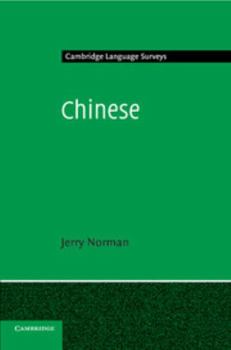Book Overview
This general introduction to the study of Chinese traces the language's history from its beginnings in the second millennium B.C. to the present, and provides a clear picture of the contemporary language and its sociolinguistic status. Chinese, in its numerous dialects, has more speakers than any other language in the modern world, and this vast extension in time and space brings to its study an exceptional complexity. Nevertheless, Norman's crisp...
Format:Paperback
Language:English
ISBN:0521296536
ISBN13:9780521296533
Release Date:January 1988
Publisher:Cambridge University Press
Length:306 Pages
Weight:1.00 lbs.
Dimensions:0.7" x 6.0" x 8.9"
Customer Reviews
4 ratings
GGGGreat Serviec! Book is in good condition!
Published by Thriftbooks.com User , 14 years ago
The whole package was delievered to me within a week, which is awesome! Besides, I was spurprised by the way it was wrapped. I really thought the plastic wrape outside was a good iead to prevent the item got damged by water. good job!
Fascinating, but be forewarned
Published by Thriftbooks.com User , 15 years ago
The other reviewers have fairly summarized this book. One must have some background in linguistics (or at least a good linguistics text or reference handy) since Norman uses standard linguistics terminology without any explanation; one should also speak at least basic modern Chinese to appreciate many of the examples. My only real complaint is that the book does not use Chinese characters, rather pinyin (with tone marks), throughout the explanations. The problem here is that one pinyin syllable can have many meanings, since Chinese is so homophonic, thus printing the character would have been more revealing for anyone who reads Chinese or can use a good Chinese dictionary. I suspect the problem was with typsetting in 1988 when the book was published. Indeed Norman wonders how the Chinese characters will survive the computer age!! With 20-20 hindsight we can see that in fact the computer age has revitalized not only Chinese but many non-Latin scripts (thank you Unicode!). It would be nice if the book were re-done with characters and some updating based on more recent scholarship. Still, I learned a tremendous amount here, it is a fascinating journey and it's hard to see how it could be much better done in the limited space of one volume.
Hard to cover a topic so massive in one volume, but it's a good overview
Published by Thriftbooks.com User , 19 years ago
Jerry Norman's overview of Chinese, part of the Cambridge Language Surveys series, is an admirably diachronic treatment. Not content to simply speak of features of the major modern dialects, Mandarin and Cantonese, Norman places very early an exploration of the historical phonology of Chinese (back to Old Chinese) and of the development of the script. His explanation of tonal development in Chinese, in which he uses the "s-hypothesis", is especially enlightening. After this very necessary basis of historical linguistics, Norman devotes a chapter each to the literary language and written vernacular, two chapters to the modern standard language (i.e. Putonghua). He examines the dialects of North and Central China in one late chapter, and the dialects of the Southeast (including the difficulty of their classification) in another. The final chapter, "Language and society", discusses how the various languages coexist in daily life and what the future may hold. As with all Cambridge Language Surveys volumes, readers must have some prior training in linguistics. Some knowledge of Mandarin at the very least will let the reader make good use of the information Norman provides. If you are looking for a general overview of Chinese and its dialects, this is a helpful resource.
A Survey of Chinese with a Historical Perspective
Published by Thriftbooks.com User , 24 years ago
There is a surprising lack of general books on the Chinese languages aimed at students and amateur linguists, and Norman's book fills this lacuna admirably. Although coverage is uneven in parts, this book presents a survey of the language that is a tribute to the author's scholarship. More importantly, lucid language maintains the reader's interest and the book is a joy to read.Many areas, including general typology, historical phonology, the writing system, the classical language, the modern language and dialectal variation, is covered to a greater or lesser extent, as are certain sociolinguistic issues relevant to the language. In particular, the historical linguistics and dialectology aspects of the language are well explained, the section on Modern Chinese being somewhat weaker.The book, however, is not aimed at complete neophytes. A certain familiarity, albeit slight, with the Chinese language and history is presupposed, and the reader needs to be aware of, if not acquainted with, the basics of historical and comparative linguistics. Nonetheless, it is far from being an abstruse work understandable only by specialists in the field.All in all, Norman has done a marvellous job in condensing the vast field of Chinese languages into a book of reasonable dimensions which is relatively error free. It will no doubt become a valuable general reference on the Chinese language.






